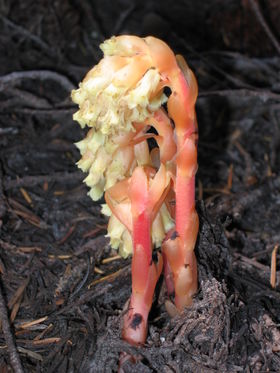Spruce asparagus family
The division of living beings into systematics is a continuous subject of research. Different systematic classifications exist side by side and one after the other. The taxon treated here has become obsolete due to new research or is not part of the group systematics presented in the German-language Wikipedia.
The spruce asparagus plants (Monotropaceae) are chlorophyll-free , perennial , herbaceous plants that are part of the forest flora in the northern hemisphere . Until the end of the 20th century they were regarded as a natural group of descent and listed as a separate family Monotropaceae (or as a subfamily Monotropoideae within the heather family ). In the meantime they have been merged with the wintergreen plants (Pyrolaceae), which used to be classified as a separate family, and incorporated into the heather plants (Ericacea) as the subfamily Monotropoideae .
species
The spruce asparagus plants contain ten genera with twelve species:
- Allotropoa virgata (western North America)
- Cheilotheca khasiana and Ch. Malayana (South and East Asia)
- Hemitomes congestum (western North America)
- Monotropa : Monotropa hypopitys (Europe, Asia and North America) and Monotropa uniflora (North America, Asia)
- Monotropastrum humile (South and East Asia)
- Monotropsis odorata (southeastern North America)
- Pityopus californicus (western North America)
- Pleuricospora fimbriolata (western North America)
- Pterospora andromedea (North America)
- Sarcodes sanguinea (western North America)
Except for Monotropa and Cheilotheca , all genera are monotypical .
Systematics
Phylogenetic analyzes using molecular genetic methods have shown that the spruce asparagus family is a paraphyletic group: the "monotropic" (chlorophyll-free) genera Sarcodes and Pterospora are more closely related to some wintergreen plants than to the other spruce asparagus plants. They therefore form the tribe Pterosporeae in the new subfamily Monotropoideae , while all other monotropic genera are placed in the tribe Monotropeae.
distribution
Representatives of the spruce asparagus family are found in coniferous and deciduous forests of the northern hemisphere , especially those made up of species of the beech (Fagaceae), willow (Salicaceae) and pine (Pinaceae) as well as wing fruiting plants (Dipterocarpaceae).
The diversity center is located in western North America with eight species (five of which are endemic ). Eastern North America and (South) East Asia have a relatively high diversity with four to five species . In Europe, however, there is only one species, the spruce asparagus ( Monotropa hypopitys L.). With occurrences in all three continents, it is the cosmopolitan among the spruce asparagus plants.
Mycotrophy
In contrast to the wintergreen plants, all spruce asparagus plants lack the chlorophyll characteristic of autotrophic plants . Plants obtain the carbon compounds they need for their nutrition from fungi in the Basidiomycota class . The woody partners of the mycorrhiza are thus parasitized indirectly via the common hyphae network ( epiparasitism ). Each genus (in some cases even species) specializes in a different genus or group of species of ectomycorrhizal fungi .
Ecologically, the myco- heterotrophic spruce asparagus plants can be summarized as "epiparasitic Monotropoideae" and differentiated from the myco- autotrophic former Pyrolaceans. However, their specialized way of life evolved within the heather family at least twice independently of one another.
literature
- Gary D. Wallace: Studies of the Monotropoideae (Ericaceae): Taxonomy and Distribution. In: The Wasmann Journal of Biology 33 (1975), pp. 1-88.
Web links
- Description (in German)
- Description (in English)
- Epiparasitism in the mycorrhiza tutorial of the ipb hall
swell
- ^ Gary D. Wallace: Interrelationships of the Subfamilies of the Ericaceae and Derivation of the Monotropoideae . In: Botaniska Notiser 128 (1975), pp. 286-298, ISSN 0006-8195
- ↑ Kron, KA & SL Johnson: Phylogenetic analysis of the monotropoids and pyroloids (Ericaceae) using nrITS and 18S sequence data. In: Am. J. Bot. 84 (6) (1997, Supplement), pp. 205-206.
- ↑ Bidartondo, MI & Bruns, TD: Extreme specificity in epiparasitic Monotropoideae (Ericaceae): widespread phylogenetic and geographic structure . In: Molecular Ecology 10 (2001), pp. 2285-2295. doi : 10.1046 / j.1365-294X.2001.01358.x
